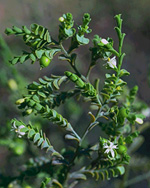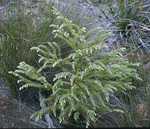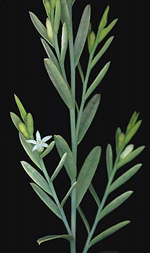 |
This small, essentially tropical family is most diverse in Africa and
Asia, but also occurs in the New World. It has a disjunct distribution
in Australia, where it is represented by three genera, Anacolosa
and Ximenia in Queensland, and several species of Olax in
various localities around the margin of the mainland. They are found in
rainforests, monsoon scrubs, coastal dune shrublands or in heathlands,
usually on light-textured, sandy soils.
Characteristic features of the family Olacaceae in Australia include: - trees or shrubs, often rather broom-like or with branches and leaves tending to be flattened in one plane
- leaves alternate, often rather thick, grey-green and 1-nerved
- flowers small, cream or greenish, axillary, solitary or in small clusters or racemes
- calyx short, often reduced to lobed rim; corolla of 4-6 petals fused into a short tube
- stamens 3, 6 or 7, short, inserted in the corolla tube
- ovary superior to half-inferior, developing into a more or less fleshy, often red, drupe
Description
Evergreen trees, or shrubs, or woody or herbaceous scrambling vines. Plants partially or totally parasitic on the roots of the host, or apparently not parasitic. Stem unarmed or rarely with thorns arising from leaf axils; internodes terete or distinctly angular. Internal secretions not obvious. Plants glabrous, or rarely bristly. Leaves well developed, or much reduced (i.e. to scales, etc.), or entirely absent, alternate and spiral, or distichous. Leaf bases imbricate or not imbricate. Leaves petiolate, subsessile or sessile. Stipules absent. Lamina simple, symmetric, filiform, acicular, subulate, linear, lanceolate, ovate, elliptic, oblanceolate, obovate or oblong; base cuneate, rounded, cordate or rarely attenuate; margins entire, ±flat; venation pinnate, with the midrib conspicuous, and the tertiary venation reticulate; surfaces not punctate; herbaceous, leathery or succulent; distinctive odour absent or foetid. Usually with all the flowers bisexual, or rarely with male and female flowers occurring on separate plants. Inflorescences axillary, consisting of glomerules, racemes, umbels or solitary flowers. Bracts present or absent. Flowers stalked. Floral disc present or absent; nectaries present on the disc. Free hypanthium present or absent. Perianth regular, of 2 dissimilar whorls or all whorls ±similar. Calyx segments fused, with 4–6 lobes, open in bud; calyx cup-shaped, herbaceous or succulent. Corolla segments fused, with 4–6 lobes, alternating with the calyx lobes, valvate in bud; corolla bell-shaped or funnel-shaped, white, cream, yellow or green, without contrasting markings, membranous or succulent; lobes ±entire. Fertile stamens 3, 6 or 7, alternating with the calyx lobes, at least partly fused to the corolla, free of the ovary and style, distinct from each other, all ±equal. Staminodes present or absent. Anthers basifixed, not versatile, opening inwards by longitudinal slits, 2-celled. Ovary superior and sessile, or part-inferior. Carpels 1–4, fused; ovary with 1–4 locules. Style terminal, single and unbranched, with the stigma capitate or lobed. Ovules 1 per locule, sessile; placentation apical. Fruit a fleshy indehiscent drupe; the perianth on the maturing fruit deciduous, dry and persistent or growing larger. Disseminule micro-surface ±smooth or finely striate or sulcate, yellow, orange, red or green, dull. Seeds 1 per fruit. Aril absent. Cotyledons 2–3 or more. Embryo straight.
(Note: this description has been generated from the coded data compiled for the key. Any errors in the key data will be reflected in the descriptions.)
A treatment of the family Olacaceae has been published in:
Flora of Australia 22: 13-26.
Australian genera of Olacaceae (as recognised for the Flora
of Australia)
Anacolosa
Olax
Ximenia

|
  |

Olax benthamiana (flowers and fruit)
Photo: M.Fagg © M.Fagg

Olax phyllanthi (flowers)
Photo: J.Wrigley © ANBG

Olax phyllanthi (habit)
Photo: J.Wrigley © ANBG

Olax stricta (flower)
Photo: M.Fagg © ANBG
|
 |
|